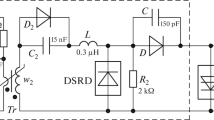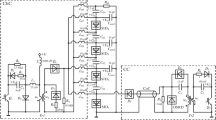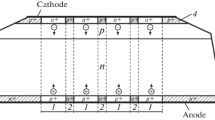Abstract
Two types of switches for high-power current pulses with an operating voltage of 24 kV based on blocks of series-connected shock-ionized dynistors are described. The switching processes of these switches are considered, and the results of their comparative study are presented. The possibility of efficient switching of nanosecond current pulses with an amplitude of 6 kA and a rise rate of 150 A/ns is shown. The prospects for increasing the switched power are determined.
Similar content being viewed by others
Avoid common mistakes on your manuscript.
Energy losses in switches of high-power pulses with a submicrosecond rise time significantly depend on the time of their switching to a high-conductivity state. Therefore, the four-layer silicon structures described in [1–4], which have a subnanosecond turn-on time due to the use of the method proposed in [5] for triggering by a nanosecond high-voltage pulse, are of great interest. With such a duration of the triggering action, the avalanche breakdown does not have time to develop, and the field strength in the base regions of the semiconductor structure increases to a value sufficient to initiate the impact ionization of silicon. This process provides a very high rate of increase in the conductivity of the silicon structure, which is not currently available for alternative semiconductor switches.
The work [6] shows the high switching capabilities of a semiconductor switch with an operating voltage of 12 kV, which is made in the form of a block of series-connected shock-ionized dynistors (SIDs) described in [7–9]. The disadvantage of such a switch is the large amplitude of the output voltage of the control circuit (~27 kV), which provides switching of all dynistor structures. This drawback makes it difficult to develop SID switches with higher operating voltage, but it can be eliminated by using several serially connected SID blocks with independent control circuits.
Figure 1 shows a diagram of an experimental generator containing an SID switch with an operating voltage of 24 kV, consisting of SID1 and SID2 blocks, which are switched on in a relay-race mode. Block SID1 is switched on by the CC control circuit, and block SID2 is switched on as a result of the discharge of the capacitor С3 due to the switching of the block SID1. In the initial state, the capacitor С3 is charged to charging voltage U0 of storage capacitor С0; voltage is applied to blocks SID1 and SID2, which is determined by the number of dynistor structures used in these blocks; capacitor С is charged to the voltage applied to the block SID1. The control circuit contains the switch Sw, capacitor С1 charged to a small voltage U1, magnetic compression link С2–Tr, and a block of drift step-recovery diodes (DSRD), first described in [10]. Сircuit C–D and resistor R eliminate the possibility of applying high voltage U0 to the control circuit.
Electric circuit of the generator based on relay-switched SID blocks. DSRD—Block of diode structures with a diameter of 20 mm; SID1, SID2—blocks of dynistor structures with a diameter of 24 mm; D—block of diodes K100F (two in series); D1—K100F; Tr—transformer (ferrite core N87 (EPCOS), four rings 29.5 × 19 × 20 mm in size, w1 = 1, w2 = 3); L0—choke (ferrite core 600 NN, four rings 31 × 20 × 6 mm in size, one turn).
Switching of blocks SID1 and SID2 is carried out as follows.
After turning on the switch Sw, a current with a fundamentally short duration (~300 ns) flows through the DSRD block in the forward direction, which ensures charge accumulation in diode structures and charges the capacitor С2. At the end of the charging process, the core of the transformer Tr is saturated and the inductance of its secondary winding decreases sharply. As a result, the capacitor С2 is discharged through the DSRD-w2 circuit and a reverse current flows through the DSRD block, which, in a fundamentally short time (~120 ns), removes the entire accumulated charge from the DSRD structures and ensures their turn-off. In the process of turning off the DSRD unit, an output current pulse of the control circuit is generated. Its amplitude is determined by the amplitude of the current flowing through the winding w2, and the rise time is determined by the turn-off time of the DSRD block (~2.5 ns).
The control circuit output current flows through the capacitor С and is switched to the SID1 block and into the SID2–L3–C3 circuit. Since, at the nanosecond front of the switched current pulse, the electrical resistance of the elements L3 and C3 is relatively large, the control circuit output current flows mainly through the SID1 block. As a result, the own capacitances of the dynistor structures of this unit are quickly charged. Current flowing through the circuit SID2–L3–C3 discharges the own capacitances of the dynistor structures of the SID2 block and provides an increase in voltage across the capacitor С3. When the voltage on the dynistor structures of the SID1 block increases to the threshold value, which initiates the process of impact ionization, they switch to a high-conductivity state in a time <1 ns. As a result, the capacitor С3 rapidly discharges through the circuit L3–SID2–SID1, and the voltage on the SID2 block increases sharply. Since the energy losses in the capacitor discharge circuit С3 are small and its capacitance is much larger than the own capacitance of the SID2 block, then the voltage on the SID2 block can reach a value significantly exceeding the voltage across the capacitor С3 at the time of switching on the SID1 unit. Block SID2 turns on when the voltage on it reaches the threshold value, which ensures the initiation of the process of impact ionization in the structures of the dynistors of this block.
In the process of switching the SID switch, the choke L0 has a large inductance, which limits the rate of change of current in the circuit of storage capacitor С0. A few nanoseconds after turning on the SID2 block, the core of the choke L0 saturates, the inductance of the choke decreases sharply, and the discharge current of the capacitor С0 grows rapidly. In the interval between the moment of switching on the SID1 block and the saturation moment of the core of the choke L0, the output current of the control circuit flows through the diode D and through the dynistors of SID1 block, providing high conductivity of the SID1 block.
Figure 2 shows an oscillogram of the current through the SID switch, corresponding to the voltage U0 = 24 kV. It is obtained using a pilot SID switch, in which the SID1 and SID2 blocks consisted of the same number of dynistor structures (six in each block). The DSRD block consisted of 25 diode structures. Capacitor С1 was charged to voltage U1 = 1.4 kV. The output current of the control circuit was ~350 A.
As can be seen from the oscillogram, the current through the SID switch has an amplitude of ~6 kA and increases at a rate of ~150 A/ns. A indicates a low electrical resistance of the SID switch.
Studies have shown that the electrical resistance of the pilot SID switch increases significantly when U0 < 20 kV. Since the trigger conditions for the SID1 block did not change, then the result obtained indicates an increase in energy losses in the SID2 block. This can be explained by the fact that, at low voltage U0, the circuit of capacitor C3 does not effectively enable the SID2 block consisting of six series-connected dynistor structures.
To ensure efficient operation in the range of the voltage U0 from 24 to 12 kV, the pilot SID switch has been optimized by reducing the number of dynistor structures in the SID2 block. In an optimized SID switch, the SID1 block contained eight dynistor structures and the SID2 had four. Increasing the number of dynistor structures in the SID1 block determined the need to increase the charging voltage of the capacitor С1 (up to 1.6 kV) and increasing the number of diode structures in the DSRD block (up to 35 pieces).
Figure 3 shows an oscillogram of the voltage drop across the optimized SID switch, which was obtained during the study of its switching process. The amplitudes of the voltage peaks are determined by the turn-on voltages of the SID1 and SID2 blocks.
An alternative way to ensure the efficient operation of a high voltage SID switch in a generator with deep regulation of the capacitor charging voltage С0 is the use of a modular design: serially connected SID units are switched autonomously using separate control circuits.
Figure 4 shows a diagram of a modular SID switch with an operating voltage of 24 kV. It consists of two SID1 and SID2 blocks with an operating voltage of 12 kV connected in series. Triggering of blocks SID1 and SID2 is carried out using the same CC based on blocks DSRD1 and DSRD2, similar to the control circuit in Fig. 1. Transformers Tr have one well-insulated turn in the primary winding. As a result, the breakdown voltage between the windings w1 and w2 significantly exceeds the maximum voltage on the SID switch.
Electrical diagram of the generator based on the modular SID switch. DSRD1, DSRD2—25 diode structures with a diameter of 20 mm; SID1, SID2—12 dynistor structures with a diameter of 24 mm; D—block of diodes K100F (two in series), D1—K100F; Tr—transformer (ferrite core N87 (EPCOS), four rings 29.5 × 19 × 20 mm in size, w1 = 1, w2 = 3); L0—choke (ferrite core 600 NN, four rings 31 × 20 × 6 mm in size, one turn).
In the diagram in Fig. 4, the formation of nanosecond pulses triggering blocks SID1 and SID2 happens as follows. After turning on the switch Sw, capacitor С1, initially charged to voltage U1 = 2.8 kV, is discharged through the windings w1 of transformers Tr. As a result, short current pulses flow through the circuits С2–DSRD1 and DSRD2–С2, which ensure the charging of capacitors С2 and accumulation of charge in diode structures of blocks DSRD1 and DSRD2. When the capacitors С2 are charged to maximum voltage, transformer cores Tr are saturated and capacitors С2 are quickly discharged through the windings w2 of transformers Tr. As a result, through blocks DSRD1 and DSRD2, rapidly increasing currents flow in the opposite direction, which remove the accumulated charge from the DSRD structures.
The entire accumulated charge is removed by the time the capacitors С2 are completely discharged and the currents through the windings w2 reach the maximum value (~300 A). At this point, the DSRD structures turn off and the currents flowing through the windings w2 are switched in the SID1–С and С–SID2 circuits. These currents provide fast charging of the own capacitances of dynistor structures of SID1 and SID2 blocks up to the switching voltage. Through the use of a common switch Sw, almost identical conditions for the formation of trigger pulses of SID1 and SID2 blocks are created.
Figure 5 shows a typical voltage oscillogram on the SID switch, illustrating the process of turning it on when the voltage is U0 = 24 kV. The step-wise shape of the voltage indicates that the SID1 and SID2 blocks turn on not simultaneously. After the leading SID block is turned on, the control circuit of the lagging SID block ensures its turn on with a small delay, which is determined by the technological spread of the parameters of the control circuit elements.
The voltage amplitude on the SID switch is defined as the sum of the amplitude values of the voltage on the leading SID block at the moment of its turn on and the voltage that is applied to the lagging SID block at that moment. It is significantly less than the sum of the amplitudes of the switching-on voltages of the SID1 and SID2 blocks, each of which uses six dynistor structures with a turn-on voltage of ~4 kV.
Comparative study of generators made according to the schemes in Figs. 1 and 4 showed that, when using the same circuit С0–L0 and the same voltage U0, discharge current of capacitor С0 was practically the same, which indicates approximately the same energy losses in SID switches with autonomous and relay-race mode sitching of SID blocks.
Since virtually the same energy (~120 mJ) stored in the capacitors С1 and С3 in the diagram in Fig. 1 and in the capacitor С1 in the diagram in Fig. 4 was also used to switch the SID blocks, we can assume that the considered high-voltage SID switches have approximately the same efficiency. Their main advantage is the possibility of increasing the operating voltage by connecting additional SID blocks.
In the considered generators, the switches Sw were made on the basis of pulse integrated thyristors with a working area of ~0.5 cm2 described in [11]. The current pulses were measured using small-sized current sensors developed by the Pearson Electronics, Inc. Voltage waveforms were obtained using a Tektronix P6015A probe.
REFERENCES
Efanov, V.M., Kardo-Sysoev, A.F., Tchashnikov, I.G., and Yarin, P.M., Proc. 1996 Int. Power Modulator Symposium, Boca Raton, FL, 1996, p. 22. https://doi.org/10.1109/MODSYM.1996.564440
Grekhov, I., Korotkov, S., and Rodin, S., IEEE Trans. Plasma Sci., 2008, vol. 36, no. 2, part 1, p. 378. https://doi.org/10.1109/TPS.2008.918661
Korotkov, S.V., Aristov, Yu.V., Voronkov, V.B., Zhmodikov, A.L., Korotkov, D.A., and Lyublinskii, A.G., Instrum. Exp. Tech., 2009, vol. 52, no. 5, p. 695. https://doi.org/10.1134/S0020441209050091
Gusev, A.I., Lyubutin, S.K., Rukin, S.N., and Tsyranov, S.N., IEEE Trans. Plasma Sci., 2016, vol. 44, no. 10, part 1, p. 1888. https://doi.org/10.1109/TPS.2016.2542343
Grekhov, I. and Kardo-Sysoev, A., Sov. Tech. Phys. Lett., 1979, vol. 5, no. 8, p. 395.
Korotkov, S.V., Aristov, Yu.V., and Korotkov, D.A., Instrum. Exp. Tech., 2022, vol. 65, no. 5, p. 750. https://doi.org/10.1134/S0020441222050074
Korotkov, S.V., Aristov, Yu.V., and Voronkov, V.B., Instrum. Exp. Tech., 2019, vol. 62, no. 2, pp. 165–168. https://doi.org/10.1134/S0020441219010111
Korotkov, S.V., Aristov, Yu.V., Zhmodikov, A.L., and Korotkov, D.A., Instrum. Exp. Tech., 2020, vol. 63, no. 5, pp. 683–688. https://doi.org/10.1134/S0020441220050176
Korotkov, S.V., Aristov, Yu.V., Korotkov, D.A., and Zhmodikov, A.L., Rev. Sci. Instrum., 2020, vol. 91, p. 084704. https://doi.org/10.1063/5.0015284
Grekhov, I., Efanov, V., Kardo-Sysoev, A., and Shenderey, S., Solid-State Electron., 1985, vol. 28, no. 6, p. 597. https://doi.org/10.1016/0038-1101(85)90130-3
Grekhov, I.V., Zhmodikov, A.L., Korotkov, S.V., Prizhimnov, S.G., and Fomenko, Yu.L., Instrum. Exp. Tech., 2016, vol. 59, no. 3, p. 351. https://doi.org/10.1134/S0020441216020202
Author information
Authors and Affiliations
Corresponding author
Rights and permissions
Open Access. This article is licensed under a Creative Commons Attribution 4.0 International License, which permits use, sharing, adaptation, distribution and reproduction in any medium or format, as long as you give appropriate credit to the original author(s) and the source, provide a link to the Creative Commons license, and indicate if changes were made. The images or other third party material in this article are included in the article’s Creative Commons license, unless indicated otherwise in a credit line to the material. If material is not included in the article’s Creative Commons license and your intended use is not permitted by statutory regulation or exceeds the permitted use, you will need to obtain permission directly from the copyright holder. To view a copy of this license, visit http://creativecommons.org/licenses/by/4.0/.
About this article
Cite this article
Korotkov, S.V., Aristov, Y.V., Zhmodikov, A.L. et al. Comparative Study of Switches of Powerful Nanosecond Pulses Based on Blocks of Series-Connected Shock-Ionized Dynistors. Instrum Exp Tech 66, 595–599 (2023). https://doi.org/10.1134/S0020441223040140
Received:
Revised:
Accepted:
Published:
Issue Date:
DOI: https://doi.org/10.1134/S0020441223040140









